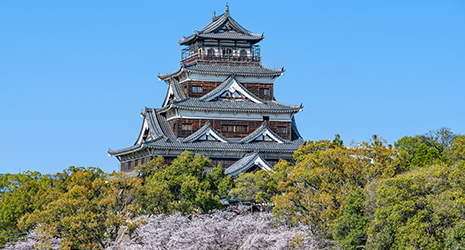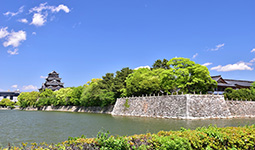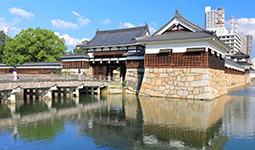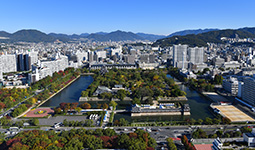April 2023
- English
- 日本語
Hiroshima Castle: A Symbol of the City

The tower of Hiroshima Castle viewed over cherry trees in blossom 
Hiroshima Castle illuminated

Hiroshima Castle viewed over the moat 
Restored buildings in the ninomaru (second compound) 
The expansive castle grounds with many trees and popular walking trails

Hiroshima Castle was built at the end of the 16th century. The castle tower, which remained until before World War II, was once destroyed by the atomic bomb, but the castle was reconstructed to its former appearance and is loved by local residents as a symbol of Hiroshima.

Hiroshima Central Park, a multi-purpose park of around 420,000 square meters, extends out over central Hiroshima. In one corner of the park lies the historic site of Hiroshima Castle Ruins. Construction began in 1589 by Mori Terumoto (1553–1625), a military commander who had control over a wide area of the Chugoku region (western Honshu) at the time, and construction was fully completed by about 1599. The completed castle occupied around 900,000 square meters and was one of the largest castles in Japan. The castle tower, a symbol of the entire castle, was five stories tall, and was an imposing building, with a height of about 40 meters* including the base. However, around 350 years after its construction, the castle collapsed from the atomic bombing of the city in the Second World War, and all that remained were the stone walls and moat.
“When the atomic bomb was dropped, the majority of Hiroshima Castle, which was within a one kilometer radius of the blast center, was reduced to ash. The wooden tower did not catch fire, but seems to have collapsed all at once from the bomb blast and other factors,” says Yamawaki Ikko, who works as principal curator at the Hiroshima City Culture Foundation.

The exterior of the tower was reconstructed in 1958 as the Hiroshima Castle Folk Museum. The reconstruction of the tower was a symbol of the reconstruction of the city itself. Later, the castle gates and turrets in the ninomaru (second compound) were also reconstructed, and the castle was restored to its former appearance by 1994.
Around the 16th century, during the Warring States period when warlords fought for power, castles were mostly built on mountains as fortresses, making use of natural land features. Hiroshima Castle by contrast was built on flat land.
“Hiroshima is located on a delta where the waters of the Ota River and other rivers flow into the Seto Inland Sea, and at the time, it was at a key location for land and sea trade. It was Mori Terumoto who noticed the location,” says Yamawaki.

When Hiroshima Castle was built, Osaka was at the center of politics, and Osaka Castle, built by Toyotomi Hideyoshi (1537–1598), and its castle town functioned together as a central hub for politics and the economy. Following this example, Mori Terumoto built Hiroshima Castle. Later, Hiroshima developed as one of the largest cities in the region, centered around Hiroshima Castle.
In the mid-late 19th century, many castles that had been the residences of feudal lords and military bases were demolished, their role having ended with the start of modernization in Japan. In the case of Hiroshima Castle, however, sections including the tower, part of the castle walls, and the interior moat were left. The tower, unchanged since it was built, had not only become familiar as a symbol of the city to local residents, but was also designated a National Treasure in 1931 for its historical value.
The interior of the tower, which was renovated in 1989, is a museum about the history of the Hiroshima castle town. From the observation platform at the top, one can see sweeping views of the city, making it very popular among tourists visiting the city both from within Japan and abroad.

Within the expansive castle grounds are a variety of trees and flowers, making it an attractive place to enjoy seasonal scenery. There are more than 1,000 trees of around 70 varieties, and in May, when the G7 Hiroshima Summit will be held, the fresh greenery will be beautiful and visitors will be able to see the flowers of the Japanese bird cherry and tabunoki (Japanese bay tree). After dark, the tower is beautifully illuminated. Hiroshima Castle continues to be a place of rest and relaxation for local residents and at the same time, a symbol.
* The castle tower alone was around 27 meters tall

